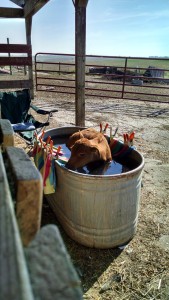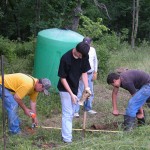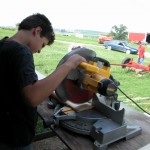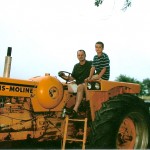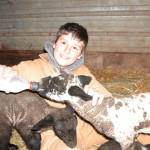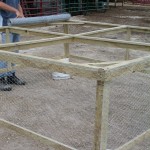Working on time management skills? You might just learn a thing or two from a cow. In the 1940's Cornell University studied cattle to see how they spent their time each day. Andre' Voisin's book, Grass Productivity has the detailed study on the efficiency of grazing cattle.
The university studied cow-calf pairs on pasture. Observers learned that cattle graze for a little less than eight hours per day. No over-time for bovine. They never exceed eight hours of grazing time.
Spend time Wisely
The cattle spent about seven hour per day ruminating (chewing their cud). The time differed slightly depending on the fiber content of the forage. Some ruminating is done lying down and part standing up.
Cattle lie down for slightly less than twelve hours per day. Cows divided these 12 hours into nine rest periods of varying length.
The cattle in the study didn't deviate in their daily routine. When they replicated the study in other countries the cattle showed the same results. In areas with hotter daytime temperatures the cattle spent no more than eight hours grazing, but they did it at night. The slight variances by breed or heredity weren't much different, they didn't change the study's results.
Quality is Everything
Here's where the efficiency of grazing cattle matters.; If cattle spend eight hours grazing each day quality is everything. If they're grazing poor pastures without nutrient dense forage they're basically spending eight hours eating junk food. Eight hours of quality forage, either pasture or hay, boost the cattle’s health. Feeding quality produces quality results.And how they're grazing matters, too. MIG grazing improves soil quality and prevents erosion.
If you're spending eight hours at something be sure to get the greatest return from those hours. Junk in - junk out. Quality counts. With organic production It's about quality not quantity.
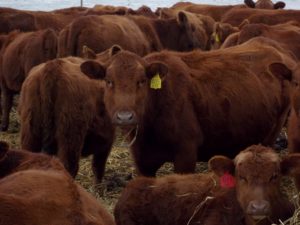
]]>
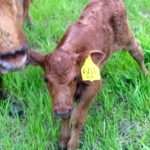
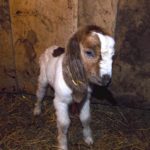
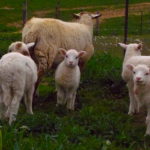
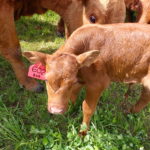
When there are new calves, kids or lambs the entire herd likes to check out the newest members. The bull calves and 'freemartin' bull calves are wearing red tags this year, the heifer calves have yellow tags.
]]>This is calving season on many farms so and we get quite a few questions about how to make a Schroeder -Thomas Splint.
The splint that Keith welded worked great for our calf. However, I recently got an email from Tracie asking for more information on the splint. I was happy to share more pictures along with a few other details.
Tracie was kind enough to send an email with a picture of their Schroeder-Thomas Splint. I think that Tracie may have improved on the design by adding a can holder for the calf's foot. However, using a cable to make the upper ring doesn't give enough support for the frame at the hip area. The cable is flexible which makes it easier to adjust but again, the upper ring is for supporting the leg.
Tracie also added a can Koozie to hold the foot inside the frame. We had used a block of wood to support the foot and held it in place with Vet Wrap and duct tape.
The key to making the splint is fitting it to the animal. Careful measurements are needed for the length and the circumference at the hip.
As a side note; all the surfaces of the frame that come in contact with skin should be padded to prevent sores from forming. This is especially important during fly season.
The spring weather is too erratic here in Iowa. Some years there's been snow on the ground late into April. Spring weather is too cold and the grass too sparse for grazing so now calving is schedule to begin in May.
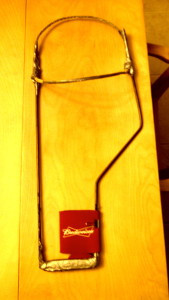
Update: April 11, 2016
Recently I've been emailing with Summer from North Dakota. They have a calf with a high, rear leg fracture. The frame they designed has an adjustable base with clamps to make the foot platform slide up or down. Summer was kind enough to share several pictures of their splint. They did a remarkable job with their calf named, Superman. He's fortunate for their loving care.
Thanks for sharing, Summer!
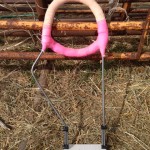
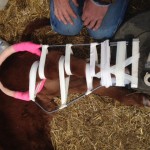
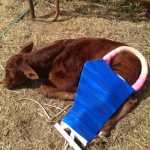
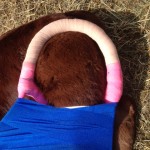
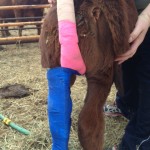 ]]>
]]>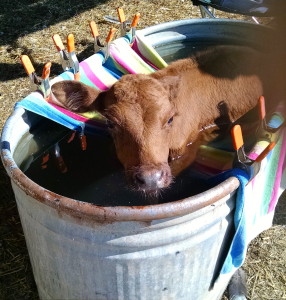
One of our late season calves got stepped on. She has a large area on her spine that's swollen and very sore. Keith took her to the vet and they started her on a protocol of anti-inflammatory medication. She can stand with help but isn't steady on her feet yet. One of the problems with cattle is the blood pressure in their legs builds up the longer they're down. In order to keep her circulation strong , without added pressure, we've made a floating tank for her.
The University Of Wisconsin School of Veterinary Medicine uses tanks to float cattle after surgery.
We're using a stock tank with an old beach towel as a sling to cradle her and keep her upright. The tank gets filled half way with hot water and topped off with cool water until it's the perfect temperature. Cold water would shock her, the water has to be warm. She floats for about 45 minutes a couple of times each day. Everyday she's getting stronger. Time will tell if she'll fully recover but for now Hope Floats.
]]>Schroeder Thomas splint
*This post is for information purposes only and does not replace the need for a qualified veterinarian*
Our veterinarian anesthetized the calf and he set the leg. We assisted by making the frame and wrapping the leg under his supervision.
This time of year we get two or three emails each week asking about the Schroeder Thomas Splint (click here for the original post).
Here are the instructions and pictures:
Our calf had a left hind leg break. These pictures are of a Schroeder-Thomas splint for a hind leg. Regardless whether front or hind leg the objective is to fix the leg in place and apply downward pressure, with the leg fully extended to set the bone in place. (The red broom handle represents the leg) Click on the pictures to view more clearly.
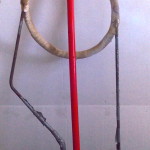
1. Measure the hip/thigh of the calf for back leg or shoulder/upper arm for front leg. We used string to measure the thigh and made a paper template of the leg. Based on those measurements Keith Used steel rod to weld this frame.
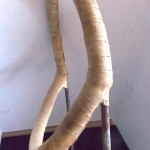
2. Weld a plate for a hoof rest at the bottom of the splint. The plate will secure the leg in place with downward pressure.
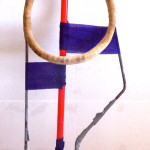
3. Fix the leg to the sides of the frame; tape alternately left side, right side, repeat as you tape the length of the leg to the frame. DO NOT WRAP THE ENTIRE LEG TO ONE SIDE: ALTERNATE THE WRAP FOR LATERAL STABILITY. (We used 3m Vet Wrap)
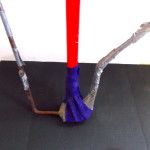
4. Wrap around the hoof and fix the leg to the bottom of the frame; apply downward pressure and fully extend the leg. A wooden splint will help hold the leg in a place to the bottom of the frame. On our first attempt we didn't have the hoof held tightly to the bottom of the frame.
5. Cushion any pressure points to prevent open sores. Apply topical fly repellant.
6. We covered all the vet wrap with duct tape for additional stability. Don't use duct tape directly on the hair coat without protective covering .
7. It will take a few days for the calf to learn to get up and down while wearing the splint. He'll get the hang of it but it will be awkward.
8. If you need help send an email, we're happy to answer questions.
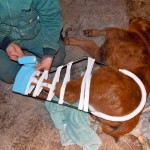
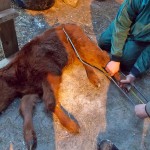
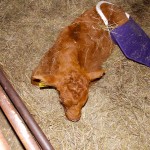
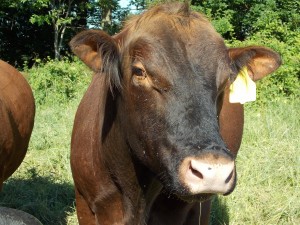 Bulls
Bulls
Typically, the bulls get turned out with the cows on the 4th of July. For the bulls, it's celebration day. This year we're thinking of holding them back for a couple extra weeks to make sure we calve when the grass is growing again. Last winter was too harsh. Spring came so late that some calves were born with snow covering the ground. We'll have two angry bulls, but the cows will appreciate calving later in the spring when the grass is abundant.
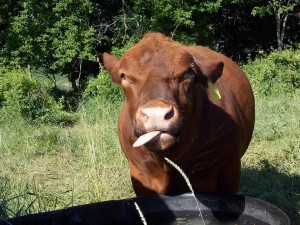
The younger bull will run with the heifers, the older one with the cows. Using this gestation table for cattle breeding we can schedule delivery with the forage cycle of our pasture. If the bulls service date is July 4, then the calving date is April 12. Heifers sometimes deliver up to ten days early, cows up to ten days late. Our target date for 2015 is May 1. The bulls will have to wait until July 23, Sorry, bulls!
]]>The cows are trained to respect the electric fence. The sheep are respectful of it, too. Every now and again we raise a few bottle lambs who aren't loyal to the flock of sheep, instead they bond with the goats who are independent and refuse to follow the grazing plan we've laid out for them. They scoot over, under and through the fence, going wherever they want. They aren't protected by the herd, which makes them vulnerable to predators, so they're kept in a separate pasture and rotated on a more limited basis. The cows get it. The sheep get it. The goats don't, and they never will. I'm talking about our MIG grazing program.
Every now and again we'll have other farmer's cows here for breeding to our bulls. There's always a learning curve with the visiting cows, especially if they have calves at their side. These calves aren't trained to the electric fence and run through before they realize there's a consequence waiting for them; a painful shock. The guest cows follow the herd, learning to wait patiently at the electric fence's gate handle for one of us to move it aside so they can advance into the next paddock. They're moved daily, which makes learning the routine a quick process.
Every summer the same few cows return for breeding. As soon as they step out of the trailer they remember the grazing system and follow the herd. They don't challenge the system, they get it, they just get it.
Attitudes are contagious. Is yours worth catching?
]]>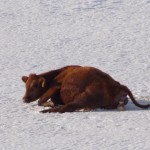
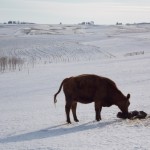
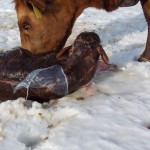
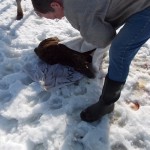
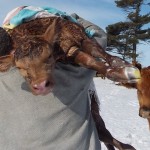

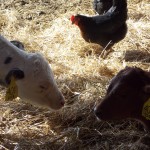
This morning there was a cow off by herself. She wasn't far from the herd, just distant enough to be on her own. She's been on the watch list. Every morning Keith checks the list of cows with their potential calving dates. This morning he said, "Number 105 should have her calf today."
Our cattle are fed in the evening which means they'll calve during daylight hours.
From a distance we kept an eye on her. After she had her new calf they were moved into the barn where they'll stay for a few days. Then she'll move into a small pasture with the other cows and their calves. They'll have access to the shed, which is bedded down and dry. With luck the pastures will be ready for grazing by mid-April. It's been a long winter.
]]>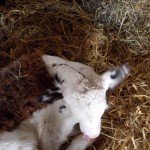
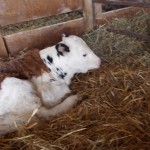
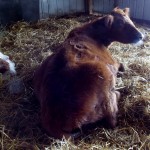
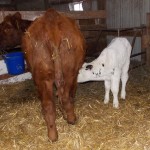
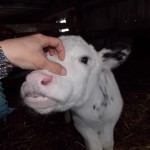
Life on a farm isn't all sunshine and roses. Sometimes it's tough, but not often, only occasionally. This week we had a heifer who laid on her calf and smothered it. Because she's a heifer with years of healthy calving ahead of her and concern that she'd get mastitis, limiting her milk production or udder health in the future, we decided grafting a calf was a good option. A neighbor who dairies had a newborn bull calf the same age as the one we'd lost. Keith cut the hide from the lost calf and tied it onto the new calf. A cow initially identifies their calf by smell, maintaining the scent of the lost calf greatly aides in the grafting process. The heifer was haltered and tied until the bull calf nursed. This was repeated several times each day for several days. In about one week the heifer accepted the calf as her own and the hide was removed.
Here are the steps to grafting a calf:
- Find a calf close in age to the lost calf
- Let the cow or heifer get a good scent of her calf before removing it from her
- Skin the lost calf
- Tie the hide to calf being grafted
- Drizzle molasses onto the new calf to encourage the cow to lick it. The more you can encourage her to smell and touch the new calf the faster the grafting process.
- Halter the cow/heifer or if necessary hobble her so she can't kick at the new calf
- Encourage the calf to nurse safely
- When the cow/heifer begins to accept the calf, allow at least 3 days, remove the hide
- The new calf will be accepted, it's just a matter of time. Heifers are easier than a cow, but eventually even a cow will give in.
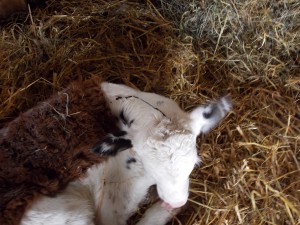
]]>
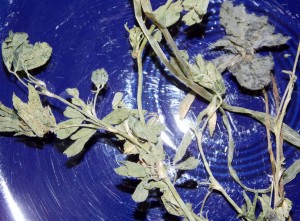 Keith brought a sprig of alfalfa into the kitchen. “The cows were pretty happy with their breakfast this morning.”
Keith brought a sprig of alfalfa into the kitchen. “The cows were pretty happy with their breakfast this morning.”
“That looks nice. The leaves are still soft and it's not too stemmy.” Keith's very proud of the hay he makes.
A few heifers are in the barnyard as they get near calving time. Three have calved already. Despite the cold weather the calves still come. The thought process last spring was to put the bull in with the heifers early, never figuring that they would cycle right away, or that the bull would catch them immediately. We were wrong. So, we have a few new calves and the cows are enjoying the best hay from last summer.
]]>
